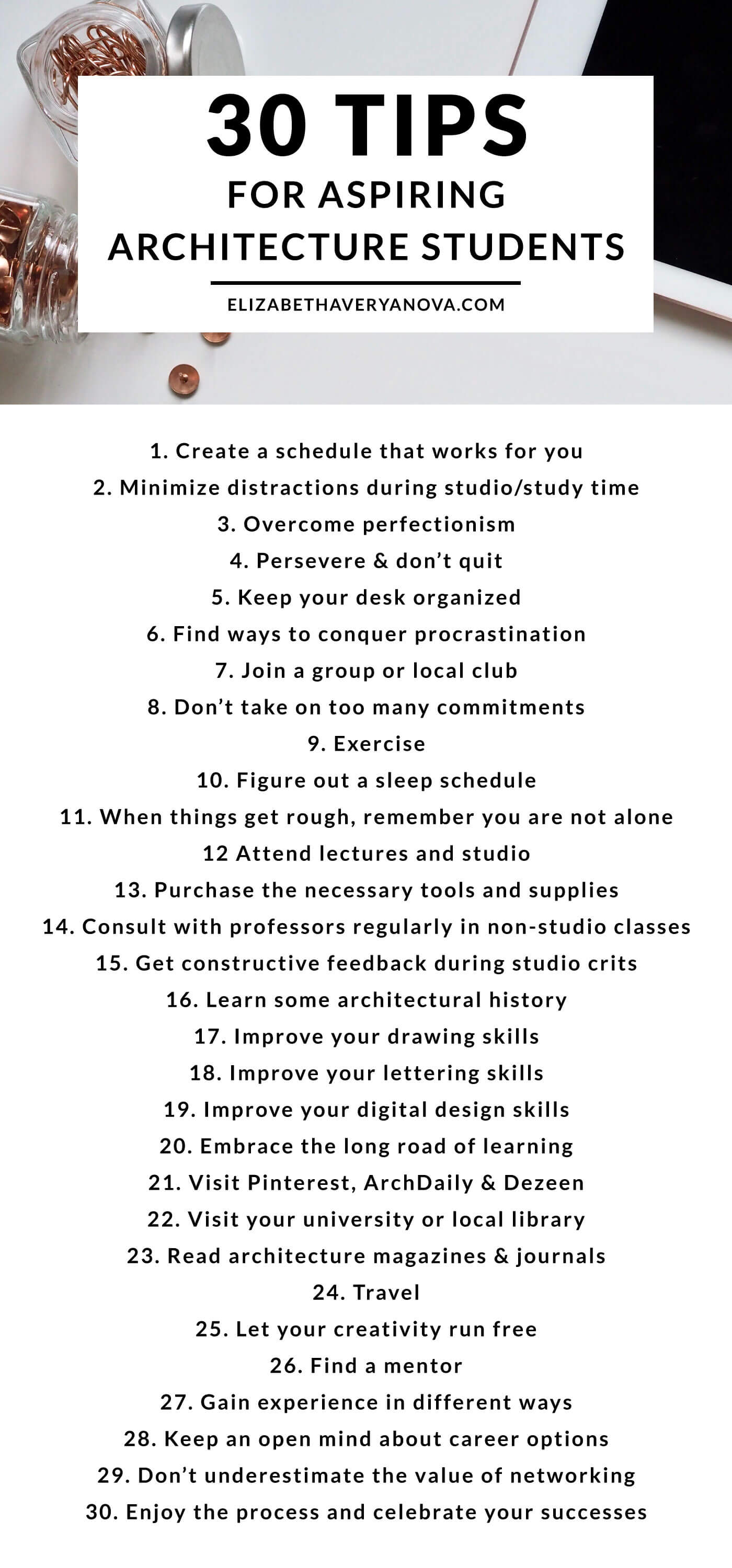
Whether you are thinking about going into architecture school or you are currently in the middle of your architecture degree studies, you may be feeling uncertain about your future and wondering how you will survive the long road ahead.
Architecture students quickly learn that school is a place in which you will experience both the highs and the lows that come with late nights in the studio, seemingly impossible project deadlines, and the long list of other required courses that make up a well-rounded architectural education (construction technology, history, theory, physics…).
The decision to pursue architecture as a career is not an easy one.
I studied architecture for five years at the University of Notre Dame, which has an amazing program specialized in traditional and classical architecture. However, it was the most challenging experience ever in my life. Nothing I had done previously had truly prepared me for architecture school.
Now I’m in the middle of earning my master’s degree in architecture in Italy, and I’ll be taking more courses in the future, but this time I feel more confident and ready than I was during my undergraduate years.
So, I wanted to share with you everything I wish I had known or done better at the time. Although this list is geared toward architecture students, it can apply to almost any design field.
Here are my top 30 tips for both aspiring and current architecture students to help you prepare for architecture school and have a less stressful experience.

PRODUCTIVITY TIPS
1. Create a schedule that works for you
You can use a simple to-do list, a beautiful paper planner, or a color-coded calendar app synced across all of your devices. Test out different approaches to creating a schedule and find something that works for you.
Without a clear study plan or agenda, it’s easy to fall behind on your schoolwork. From semester to semester and year to year, your priorities will change and your schedule will need to be adjusted. Regardless, you should develop a method for staying on top of deadlines, course schedules, meetings, exams, and other tasks.
I’ve experimented with a lot of different planners and scheduling methods over the years to keep track of everything. On a day-to-day basis, I learned to get things done by recognizing when I had higher and lower levels of energy (i.e. when I was tired, at the end of a day, after a series of lectures, etc.) Then, I tried to identify high energy tasks (things that need a lot of focus and concentration) and low energy tasks (things that could be done easily even when tired), and schedule them accordingly.
You may not be someone who finds it enjoyable to make a list of deadlines and cross things off once you finish them. If so, you’ll need at least a basic planner to stay on top of important dates. Start by writing down every deadline, exam date, and commitment in your planner and update it regularly.
2. Minimize distractions during studio/study time
When it’s time to work, do your best to cut out other distractions. Leave your phone on the charger, in another room, or inside your bag. Out of sight, out of mind, as they say. Turn off sound notifications and Wi-Fi on your devices, too.
If it’s too hard to go completely offline for a couple hours, try it for shorter increments of time using the Pomodoro Technique. Basically how this time management method works is this: set a timer and go offline for 25 minutes, then check for updates for 5 minutes, and then resume offline status for another 25 minutes.
The aim is to increase your focus and productivity while reducing time wasted from small increments of interruptions – checking social media, opening multiple tabs on your browser, answering incoming phone calls, etc.
3. Overcome perfectionism
There is nothing wrong with setting high standards for yourself, but a perfectionist tends to create an immaculate vision of what they want their design studio project to look like. It comes from the desire for every detail to be flawlessly, perfectly executed. Anything less is considered a failure.
This was one of my greatest struggles during undergraduate studies, so I know firsthand how difficult it can be to overcome.
Architecture students often face difficult deadlines, but you need to recognize that time is limited and perfectionism is a hindrance to completing your work.
If you find yourself conjuring up unrealistic expectations for your work that are impossible to achieve within the deadlines, then you need to re-evaluate the big picture and do what is necessary to achieve a good outcome for your project. It’s important to realize that you can endlessly improve a project, but sometimes you need to let go and accept that you have done your best.
4. Persevere & don’t quit
You will face many moments in architecture when you will want to quit and change careers. When you face obstacles, resistance, or disappointing results, just know that it will pass soon enough. Continue to work toward your goals or deadlines. In the end, all of your hard work will be worth it.
5. Keep your desk organized
Nothing improves productivity more than an inspiring environment and a clean desk. For me, the perfect environment is a large minimalist desk with only the essentials at hand. If there is clutter or unnecessary items on the desk, it stresses me out. Before I start to work, I take a moment to tidy up my desk. Less distraction, better focus.
You don’t have to be a minimalist, but one way to improve your productivity is to organize your studio desk or your home study space.
6. Find ways to conquer procrastination
Like most architecture students, I used to invent all kinds of reasons to procrastinate on design studio projects. Once I started freelancing and working directly with clients, I quickly learned the importance of meeting and exceeding project deadlines. There is no room for procrastination when your professionalism (and your next paycheck) depends on your ability to get things done on time and to the best of your abilities.
One way that I am able to conquer procrastination is to ask myself a series of questions that help me recognize when and why I am avoiding something that I don’t want to do.
Ask yourself: what is blocking you from getting started? Is it lack of clarity? If so, write down step-by-step exactly what needs to be done to accomplish the task. Is it the difficulty of the task? If so, do you need to ask for help? Or, is it the sheer amount of work you need to get done? If this is the case, break down each major project milestone into smaller steps, and just focus on finishing the next step.
PHYSICAL & MENTAL HEALTH TIPS
7. Join a group or local club
A great way to keep your sanity in architecture school is to become involved in at least one hobby or activity outside of your architecture courses. It can be a sports group, music ensemble, theatre troupe, student newspaper – anything that interests you.
Check out your university’s events, student organizations, residence hall groups, or search online for interesting local happenings. You can meet new people who share the same interests besides architecture, and it can be an enjoyable change of pace from your studies.
8. Don’t take on too many commitments
Doing your best and seeing something through to completion is absolutely important in all areas of your life. But it’s easy to take on too many responsibilities and get overwhelmed by it all.
I learned this the hard way, more than once. There were so many interesting courses or things to do on campus, and I always started each new semester with ambitious and overly optimistic plans. During a few semesters in college, I convinced my academic advisor to allow me to enroll in 21 credit hours. Normally undergraduate students take 15 credit hours (about 4 or 5 courses). I wanted to do an extra oil painting class (a 6th course), as well as two music ensembles (1 credit hour each) and weekly private music lessons (1 credit hour). Ultimately it was too much for me to handle! I had to drop the oil painting class midway through the semester.
I learned a valuable lesson in the end: be realistic about the number of commitments you take on, but sometimes it’s okay to quit.
There are valid reasons for deciding to quit something. Priorities can shift, life can change. Weigh your options, and realize that quitting is not the same thing as failure. You may feel guilty or self-defeated for a period of time after deciding to quit. However, in the long run, quitting something that is too challenging to complete or doesn’t make you excited allows you to focus better on other areas of your life.
9. Exercise
No matter how busy you are, exercise at least 2-3 times per week. Your physical well-being plays a major role in your ability to get things done. Even a 40-minute walk can make a difference. It can be a nice break from your studies or work, and regular exercise can help you sleep better, too. Put it in your planner to go for a run, do yoga at home, head to the gym, or join a fitness group.
10. Figure out a sleep schedule
Architecture students have the ability to find the most creative and ridiculous ways to escape the need for sleep: makeshift beds with pillows under their studio desk, excessive consumption of Starbucks, coffee, and energy drinks, unofficial competition for how many consecutive hours you can stay awake, experimenting with alternative sleep routines, and even more tactics to conquer the necessity of sleep. Thus, the mainstream advice to get eight hours of sleep every night is a lofty goal for most architecture students, especially toward the end of a semester.
Everybody is different when it comes to how much sleep you need and how well you can function without sleep. More often than not, the reality is you have a studio project deadline looming and not enough hours in the day to finish it. Sleep is the last thing you want to do.
My suggestion is to find ways to stay ahead with your work and minimize sleep deprivation in the first place by following the other tips in this list!
11. When things get rough, remember you are not alone
There may be times when you feel like you are at the bottom of a deep sea of emotions and can’t get out. If you are struggling with any kind of personal issue such as extreme stress, depression, eating disorders, or other complicated situations, it can often be aggravated by architecture studio deadlines and consecutive all-nighters.
You have to remember, though, that you are not alone. Your studio project is not more important than your personal well-being. Seek out professional counseling, call a support line, or go to your university health center. There are many people who care about you and will be there for you, if you reach out.
If you are afraid to seek out help and if talking to someone is the last thing you feel like doing, I understand. Try to find at least one friend, family member, or professor with whom you can talk. Although they are not professionally trained to guide someone with mental health issues, a listening ear can be the first step toward getting out of this situation and into a better place.
TIPS FOR CLASSROOM & STUDIO SUCCESS
12. Attend lectures and studio
This is really simple, obvious advice: don’t skip class. Don’t skip your structures course or history lectures to spend more time in studio. You are missing out on beneficial information. When exam time comes, you will have a harder time doing well, and your professor will have less sympathy for you if you missed a bunch of lectures.
In many architecture studio courses, students are required to have at least 75% attendance rate, otherwise they risk not being allowed to take the exam and pass the course. It’s understandable if you miss class once or twice, but if you find yourself skipping class more often, you might want to reanalyze your priorities, your weekly schedule, your sleep habits, or whatever is causing you to skip class.
13. Purchase the necessary tools and supplies
I always heard stories about college students in arts & letters programs or science majors spending anywhere from $400 to $800 on textbooks every semester. As an architecture student, I never had to spend that much money on required reading materials. However, we did have to buy a lot of art and drawing supplies!
Every new project was another excuse to visit the art store to buy watercolor paper or other necessary items. I loved shopping for new watercolor paint tubes, unique handmade paper, different types of modelmaking supplies, fancy sketchbooks, and more. Over the years, I’ve learned the value of buying the right tools and materials for the job. As an aspiring architect, learning how to use different tools to design and create architectural drawings is an essential skill.
- Recommended Reading: 14 Must-Have Design Tools for Architecture Studio
14. Consult with professors regularly in non-studio classes
I know a lot of architecture students tend to consider their non-studio classes, especially their non-architecture classes, as less important. However, there is a reason for every required class you need to take, whether it’s philosophy, mathematics, or a literature course.
Vitruvius even wrote about the importance of a well-rounded architect. Over the years, I have learned a lot from consulting with my non-architecture professors.
Here’s how you can get started with this. At the beginning of each semester, identify when and where your professors have office hours. Plan to visit their office hours during the first few weeks of the semester. Email them the night or two before you plan to drop by, and make sure to show up during the specified time. Ideally, you should have a few short, meaningful questions ready to ask them, either about a specific assignment you will have to do or about a topic from one of their recent lectures. If you can’t think of anything to ask them, it’s not a problem. I recommend simply to introduce yourself, tell them you are an architecture student, and that you don’t know very much about this subject but it seems interesting to you. I think most professors are happy to meet their students for one-on-one discussion and hear their perspectives on life and studies.
15. Get constructive feedback during studio crits
You worked hard all week on your project and stayed up late the night before to put the finishing touches. You are ready to show and discuss your latest drawings and ideas with your studio professor. During studio time, you consult and s/he seems pleased with your work. Then s/he gives you some helpful guidance for improving your design. That’s the ideal situation, right?
Studio crits are not always that smooth sailing. In fact, they can be something you end up dreading. Studio crits are even known to bring tears to some students.
What do you do if you have a difficult, egotistical professor who has no intention of supporting your design approach?
What do you do if you have a great professor, but you are terribly behind on your project and unprepared to discuss your project when it is time for studio?
Just remember that the main goal of studio time is to get constructive feedback for the current state of your design project so that you can continue forward with it.
16. Learn some architectural history
Most architecture students can be divided into two categories when it comes to history. They either love it, or they find it incredibly boring and wish they didn’t have to take history courses.
While there’s no hiding that architectural history is among my favorite topics, and I could happily study almost any period of history, I realize it’s not for everybody. I believe history has a lot to offer, and I think it’s important to learn about the past in order to design the future.
You don’t have to force yourself to become a history lover, but I encourage you to find at least one period of time in history that interests you and read some books on the subject.
17. Improve your drawing skills
Drawing is the core of an architect’s work. Learning to draw well by hand is a valuable, lifelong asset to your career in architecture.
Most people aren’t born gifted at drawing. Nonetheless, it is a skill that anyone at any age can learn.
A great book that I recommend to get started is Drawing on the Right Side of the Brain.
18. Improve your lettering skills
Lettering by hand adds an element of artistry to your architectural drawings that can’t be achieved as easily by most people on a computer.
Find some tutorials to improve your handwriting. Use a ruler to create straight guidelines to help. Print off a sample alphabet to mimic, and practice, practice, practice your lettering skills.
19. Improve your digital design skills
Revit or ArchiCAD? Adobe Photoshop or Illustrator? Sketchup, Lumion, Mudbox, Rhino…. the list of digital software is endless these days.
These digital design tools can help you visually represent, illustrate, and communicate your vision and ideas in architecture in ways that are different from hand drawings and hand renderings. Both are valuable skills to have in your tool set.
If you don’t have the option to take courses in CAD or 3D, then teach yourself or take online courses at your own pace.
20. Embrace the long road of learning
Architecture is a demanding field, and you will be expected to know many different aspects of the building process. After four or five years of undergraduate education, you are only beginning to tap the surface of the endless array of subjects in architecture.
That’s the exciting thing about architecture. It’s a diverse, always changing, multi-faceted field. There are constantly new trends, new technology, new buildings being constructed, and new books being published. The best architects are the ones who embrace being a lifelong student of architecture.
TIPS FOR FINDING INSPIRATION
21. Visit Pinterest, ArchDaily, & Dezeen
For each of your projects, create Pinterest boards and gather the most inspiring images. Visit useful architectural sites to find good sources of design inspiration and case studies of contemporary projects.
For example, you can use site such as ArchDaily to search by building type and find photographs, floor plans, and elevation drawings of similar building types.
22. Visit your university or local library
We were lucky at my undergraduate university to have an incredible architecture librarian who remains the most enthusiastic, passionate person I know about architecture books and publications. Whenever I brought up a new book that the library didn’t have, she would already have it ordered for the library’s collection before I even finished the conversation. That’s serious passion and dedication!
If you want to be a successful architecture student, I think it’s essential to learn how to use the library. It can become your best resource for finding inspiration for studio projects and architecture history papers.
Make friends with the librarians, ask them for book recommendations and advice when you are researching an architectural topic, and take advantage of the opportunity to access rare book collections, interlibrary loans, and large-format book scanners (all things I missed once I graduated).
23. Read architecture magazines & journals
You don’t have to worry about buying subscriptions to architecture magazines as a student. All you have to do is take a short break from studio and wander into your university library (see tip above) to the section called Periodicals. Here you can find all kinds of architecture, architecture history, construction technology, and interior design journals and magazines, both current and older editions.
If you are stuck for inspiration and want a different perspective, browse through a few magazines, whatever catches your eye.
24. Travel
The best education that an aspiring architect can have is traveling to new places and experiencing buildings first-hand. You begin to understand architecture in new, transformative ways when you travel.
Travel can happen in both small and big ways. If time or budget is limited, take a bike ride to a new part of town, go for a day trip to the nearest big city, or visit a local museum. If you have the opportunity to study abroad, go for it.
Take pictures, sketch, observe, and reflect on the urban squares, built structures, and interior spaces. I love visiting old European cities, new traditional buildings, and other contemporary work to get a range of perspectives.
25. Let your creativity run free
In school, you have the opportunity to experiment during the process of designing spaces, places, and buildings. You can create a beautiful, functional design with elements of surprise and inventiveness. It is a fantastic time when your projects don’t have construction budget limitations, client programming needs, building code requirements, and bureaucratic red tape.
Later in life, all of these things can pose limitations to the design and creativity process. You may not have this much creative opportunity in your first or second job out of school, so make the most of it.
CAREER TIPS FOR ARCHITECTURE STUDENTS
26. Find a mentor
The word ‘mentor’ can sound pretty intimidating. I used to think you had to ask someone formally, “Can you be my mentor?” Over the years, I realized that’s not the case. It’s something that develops naturally over time.
A mentor can be a professor, an academic advisor, a past employer, a friend’s parent, or a family member. It is someone in your life who is a role model to you, who inspires you to set and achieve your goals, and ideally who ‘gets’ architects. A mentor can help guide you when making career decisions, can act as a sound board for your ideas, can share both successes and failures with you, and can be someone just to talk to on a bad day.
My piece of advice for maintaining a good relationship with a mentor? Respect their time, always say thank you when they help you, and follow up to let them know how things are going.
27. Gain experience in different ways
You can study architecture for years and seek knowledge from more experienced architects, but without gaining some real-world experience, it can be hard to get an accurate picture of what this industry looks like. Keep an open mind about different types of experience you can pursue while still a student.
The most common approach is to find an internship in an architecture office during the summer months. If this isn’t possible, there are other ways to gain valuable experience. You can participate in a community build or volunteer for a Habitat for Humanity project to gain construction experience. Or, you can reach out to someone in architecture and ask them for an informational interview or a shadow day. This you can give you an inside look at their job.
You can also create your own DIY projects, such as starting a blog, launching an Etsy shop, or crafting furniture. These could be a great way to expand your design skills, however big or small.
28. Keep an open mind about career options
In past decades, most architecture students graduated from university to eventually become architects. Nowadays this is no longer the case. There are many diverse opportunities you can pursue while having an architectural background.
Architecture spans across many dynamic, creative, multi-disciplinary industries including fashion, product design, publishing, virtual reality, and BIM technology. You are not limited to just becoming an architect. (And, you are also not a failure if you don’t eventually become a licensed architect.)
29. Don’t underestimate the value of networking
Even as a student, you can begin networking with people in the architecture profession. You’re in an ideal situation right now where you are learning new things constantly and working hard towards your degree. Thus, you have a fresh perspective and interesting things to talk about.
Set a goal to connect with people who are five to ten years ahead of you in their architecture careers and who have the results you want. Make new connections online and at conferences, exhibitions, lectures, and other industry events.
30. Enjoy the process and celebrate your successes
When you finish your studio project or pass a difficult exam, reward yourself for a job well done. Go out for a nice meal, take a day trip, buy something for yourself, and enjoy the feeling of accomplishment. It encourages your brain to keep working hard toward the next major milestone. It also motivates you to keep maintaining good habits, setting goals, and dreaming big.
Here’s a free printable version of this list! If you enjoyed this post, I would love for you to share it on Pinterest!

Do you have any tips that guided you through your architecture studies in college or university? Let me know in the comments!

Hi, I’m Elizabeth! I’m an Web & Architectural Designer, Brand Strategist, Digital Course Creator, and Business Coach for Designers, Aspiring Architects, and Service-Based Entrepreneurs. I help designers and aspiring architects thrive in the design world by organizing their life, mastering their mindset, learning architecture & design skills, and building a professional career or online business they love. – Read my full story here!




